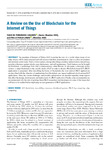Mostrar o rexistro simple do ítem
A Review on the Use of Blockchain for the Internet of Things
| dc.contributor.author | Fernández-Caramés, Tiago M. | |
| dc.contributor.author | Fraga-Lamas, Paula | |
| dc.date.accessioned | 2024-01-29T14:23:04Z | |
| dc.date.available | 2024-01-29T14:23:04Z | |
| dc.date.issued | 2018 | |
| dc.identifier.citation | T. M. Fernandez-Carames y P. Fraga-Lamas, «A Review on the Use of Blockchain for the Internet of Things», IEEE Access, vol. 6, pp. 32979-33001, 2018, doi: 10.1109/ACCESS.2018.2842685. | es_ES |
| dc.identifier.issn | 2169-3536 | |
| dc.identifier.uri | http://hdl.handle.net/2183/35184 | |
| dc.description.abstract | [Absctract]: Web automation applications are widely used for different purposes such as B2B integration, web mashups, automated testing of web applications, Internet metasearch or technology and business watch. One crucial part in intensive web automation applications, that require real time responses, is for them to execute the navigation sequences in the shortest possible time. The approach of building the automatic web navigation component by using the APIs of conventional browsers, followed by most of the current systems, is not appropriate in that scenario, because it presents performance problems. Other approach consist in creating custom browsers specially designed for web automation, which can develop some improvements based in the peculiarities of the web automation tasks. In this work, we present a new set of techniques and algorithms that allow the parallel evaluation of the scripting code when a custom browser loads a web page. We also outline the components that should be included in the custom browser architecture to implement these techniques. The tests executed with real web sources, to evaluate the validity of our proposal, show that a custom web browser loads the web pages faster when the scripts are executed in parallel using the designed techniques. The paradigm of Internet of Things (IoT) is paving the way for a world, where many of our daily objects will be interconnected and will interact with their environment in order to collect information and automate certain tasks. Such a vision requires, among other things, seamless authentication, data privacy, security, robustness against attacks, easy deployment, and self-maintenance. Such features can be brought by blockchain, a technology born with a cryptocurrency called Bitcoin. In this paper, a thorough review on how to adapt blockchain to the specific needs of IoT in order to develop Blockchain-based IoT (BIoT) applications is presented. After describing the basics of blockchain, the most relevant BIoT applications are described with the objective of emphasizing how blockchain can impact traditional cloud-centered IoT applications. Then, the current challenges and possible optimizations are detailed regarding many aspects that affect the design, development, and deployment of a BIoT application. Finally, some recommendations are enumerated with the aim of guiding future BIoT researchers and developers on some of the issues that will have to be tackled before deploying the next generation of BIoT applications. | es_ES |
| dc.description.sponsorship | This work was supported in part by the Xunta de Galicia under Grant ED431C 2016-045, Grant ED341D R2016/012, and Grant ED431G/01, in part by the Agencia Estatal de Investigación of Spain under Grant TEC2015-69648-REDC and Grant TEC2016-75067-C4-1-R, and in part by ERDF funds of EU under Grant AEI/FEDER, UE. The work of P. Fraga-Lamas was supported in part by BBVA and the BritishSpanish Society Grant. | |
| dc.description.sponsorship | Xunta de Galicia; ED431C 2016-045 | |
| dc.description.sponsorship | Xunta de Galicia; ED341D R2016/012 | |
| dc.description.sponsorship | Xunta de Galicia; ED431G/01 | |
| dc.language.iso | eng | es_ES |
| dc.publisher | IEEE | es_ES |
| dc.relation | info:eu-repo/grantAgreement/MINECO/Plan Estatal de Investigación Científica y Técnica y de Innovación 2013-2016/TEC2015-69648-REDC/ES/RED COMONSENS | |
| dc.relation | info:eu-repo/grantAgreement/MINECO/Plan Estatal de Investigación Científica y Técnica y de Innovación 2013-2016/TEC2016-75067-C4-1-R/ES/CODIFICACIÓN Y PROCESADO DE SEÑALES PARA REDES EMERGENTES DE COMUNICACIÓN Y DE SENSORES INALÁMBRICAS | |
| dc.relation.uri | https://doi.org/10.1109/ACCESS.2018.2842685 | es_ES |
| dc.rights | Atribución 3.0 España | es_ES |
| dc.rights.uri | http://creativecommons.org/licenses/by/3.0/es/ | * |
| dc.subject | IoT | es_ES |
| dc.subject | Blockchain | es_ES |
| dc.subject | Traceability | es_ES |
| dc.subject | Consensus | es_ES |
| dc.subject | Distributed systems | es_ES |
| dc.subject | BIoT | es_ES |
| dc.subject | Fog computing | es_ES |
| dc.subject | Edge computing | es_ES |
| dc.title | A Review on the Use of Blockchain for the Internet of Things | es_ES |
| dc.type | info:eu-repo/semantics/article | es_ES |
| dc.rights.access | info:eu-repo/semantics/openAccess | es_ES |
| UDC.journalTitle | IEEE Access | es_ES |
| UDC.volume | 6 | es_ES |
| UDC.startPage | 32979 | es_ES |
| UDC.endPage | 33001 | es_ES |
Ficheiros no ítem
Este ítem aparece na(s) seguinte(s) colección(s)
-
GI-GTEC - Artigos [190]






